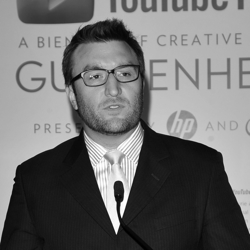How has the relationship between the orchestra and its community changed over the past century? (more…)
Posts Tagged ‘ed sanders’
-
Video: The Changing Landscape
Topic: Audience, Community, Creativity | Tags: alan gilbert, ed sanders, jesse rosen, margo drakos, mason bates, matthew vanbesien, neil harris, video
October 16, 2012 by Beth Hondl | Comments (0)
-
Video: Technology and Engaged Audiences
How can orchestras use technology to engage with audiences? (more…)
Topic: Audience, Creativity | Tags: Afa Sadykhly Dworkin, brent assink, ed sanders, elizabeth scott, margo drakos, mason bates, matthew vanbesien, sunil iyengar, technology, video
October 15, 2012 by Beth Hondl | Comments (0)
-
Podcast: Chapter Nine – Considering Audiences, Part 2
Confronted with fundamental and ongoing changes in their audiences, orchestras are thinking about what they do and how they do it as never before. In this chapter we explore some of the ideas, innovations, optimism and uneasiness of the American orchestra, as it finds it way toward the audiences of the future.
This podcast was developed from our May 2012 live forum event and backstage interviews.
Chapter Nine – Considering Audiences, Part 2
Play | Download | Transcript
Topic: Audience | Tags: alan gilbert, brent assink, ed sanders, elizabeth scott, franz welser-möst, matthew van besien, podcast, sunil iyengar, Yannick Nézet-Séguin
July 26, 2012 by Beth Hondl | Comments (0)
-
Podcast: Chapter Six – The Creative Challenge, Off the Stage
In a culture that exalts the individual, creativity is thought of first and foremost as the distinctive stamp of a personality, the outpouring of a specific genius or talent. But organizations can and must be creative, too, if they hope to endure and thrive. In the face of financial woes, aging audiences, dwindling arts education and the momentum of an increasingly digital universe, orchestras are challenged as never before to find creative ways of making music and making it matter to their communities.
This podcast was developed from our public forum in March 2012, Talking About Creativity and a “Conducting Business” podcast by New York radio station WQXR.
Chapter Six – The Creative Challenge, Off the Stage
Play | Download | Transcript
Topic: Creativity | Tags: brent assink, christopher pinelo, ed sanders, john adams, john shafer, margo drakos, mason bates, mtt, podcast, steve winn
May 24, 2012 by Beth Hondl | Comments (0)
-
Event video: Talking About Creativity Roundtable and Audience Q&A
One last video from our Talking About Creativity event in San Francisco is now available for viewing — the roundtable discussion and audience Q&A.
Read the Talking About Creativity Roundtable transcript (pdf)
Participants include: Mark Clague, Professor of Music, University of Michigan; Ed Sanders, Group Marketing Manager, Creative Lab at Google; Margo Drakos, cellist and Co-founder, InstantEncore; John Adams, composer; Mason Bates, composer; Brent Assink, Executive Director, San Francisco Symphony; and Steven Winn, San Francisco arts journalist and critic.
Topic: Creativity | Tags: brent assink, ed sanders, john adams, margo drakos, mark clague, mason bates, steven winn, video
April 23, 2012 by Beth Hondl | Comments (0)
-
Event video: Ed Sanders, Margo Drakos, Steven Winn – Talking About Creativity
This is Spotlight Conversation #2 from our Talking About Creativity event in San Francisco, March 17, 2012.
Ed Sanders, formerly of YouTube, now Group Marketing Manager of the Creative Lab at Google, and Margo Drakos, cellist turned tech entrepreneur and Co-founder of InstantEncore, talk about the YouTube Symphony Orchestra, how technology can serve as a tool for classical musicians, the need to embrace change, plus much more. Moderated by Steven Winn.
Topic: Creativity | Tags: ed sanders, margo drakos, steven winn, video, youtube symphony
March 21, 2012 by Beth Hondl | Comments (2)
-
What made the YouTube Symphony successful? A Q&A with Ed Sanders of Google
The YouTube Symphony Orchestra started out as a suggestion from a young marketing employee in London. What if…? What if we could bring together classical music enthusiasts dispersed across the globe? How could technology bring this community together? 30+ million views later, the YouTube Symphony Orchestra became an international phenomenon and in this Q&A Ed Sanders—formerly of YouTube, now Group Marketing Manager of the Creative Lab at Google—explains how that happened.
 Question: What brought about the development of the YouTube Symphony Orchestra? Was it that YouTube noticed that the genre was developing in popularity? Or what make the organization feel it would be an interesting activity to present in such a futuristic way?
Question: What brought about the development of the YouTube Symphony Orchestra? Was it that YouTube noticed that the genre was developing in popularity? Or what make the organization feel it would be an interesting activity to present in such a futuristic way? Ed Sanders: YouTube and Google have always prided themselves on having a distinctly entrepreneurial culture. This is a reflection of that. The idea came from a young marketing employee in the London office, who dreamed up the idea, pitched it, and it became reality. One of the major original data points which piqued interest was the massive yet highly fragmented existing classical music which lived online on platforms like YouTube. But the concept itself is merely one example of an ongoing demo which perhaps only YouTube could do – a manifestation of a wonderful way to showcase the access which YouTube provides, to transcend linguistic and geographic boundaries, and to continually strive to challenge the status quo.
Question: What do you think captured the imagination of viewers about this project? Was part of it this idea that it was so accessible, available to anyone with a computer? (more…)
Topic: Creativity | Tags: ed sanders, video, youtube symphony
March 13, 2012 by Beth Hondl | Comments (0)


